A Diet Green New Deal: Relief, Recovery, and Transformation?
Although he might still be insisting otherwise, Donald Trump lost the 2020 presidential election. Joe Biden secured a victory with a record-breaking popular vote and the necessary electoral college votes to safely secure the presidency. Biden won the presidency, and the Democrats have a majority in the House of Representatives. However, with a historically obstructionist Senate, it is unlikely that any significant policy action can be pursued should the Democrats fail to win a Senate majority.
COVID-19 Policy Action to Date
The Senate passed the CARES act in late March. To date, no additional federal relief has been made available for individuals facing joblessness and homelessness beyond the initial $1,500 stimulus payments in April.
I wanted to explore ways in which a different policy response could provide a combination of necessary immediate relief and long-term recovery that would transform the economy as envisioned under existing Green New Deal policy proposals.

This scenario is not quite the Green New Deal as envisioned by AOC, or even that envisioned by the Biden Transition team. It is perhaps best understood as a Diet Green New Deal – one which takes a less optimistic view of the possibilities for ‘Building Back Better’ than that presented by the Biden transition team, based on likely political constraints.
Sizeable compromises are made with a Republican-controlled Senate, and as a result the objectives of the Green New Deal are not fully realised. Nevertheless, it still marks a substantive break from ‘business as usual’.
Method
Cambridge Econometrics’ E3-US Model was used to model the Diet Green New Deal scenario.
The E3-US model is a unique dynamic macro econometric stimulation model, developed as a tool for policy analysis. The model combines an accounting framework with a set of parameters that have been estimated econometrically from a detailed time-series database. Changes in the electricity sector are captured via the Future Technology Transition (FTT) sub-module, which models the three major US electrical grids.
Diet Green New Deal Policy Assumptions
The Diet Green New Deal scenario that I explored includes the impacts of COVID-19, and some policies to boost recovery from the effects of the pandemic through to 2035:
- Government spending on healthcare – consistent with objectives laid out in the Biden-Harris plan to beat COVID-19
- Investment in transport infrastructure
- Support to small businesses and industry – this support starts as immediate relief funds in 2021 and runs through 2025. From 2025 onwards, the level of stimulus spending is reduced as industry recovers
- Policies to support the take-up of low-cost renewable energy
- The phase-out of coal-fired electricity generation in many states
Upsides – Consistent with Previously Agreed NDCs
Despite the ‘Diet’ nature of the scenario, it still delivers on the previous Nationally Determined Contribution (NDC) communicated by the United States, when it was still a party to the Paris Agreement. By phasing out large shares of coal-fired electricity generation, total emissions fall approximately 30% relative to 2005 levels – this exceeds the commitment made in 2015.
Estimated Impact
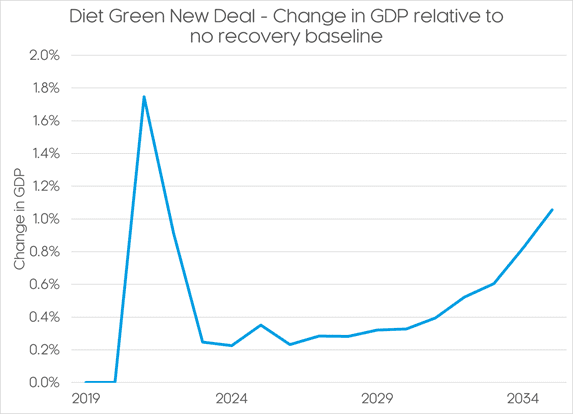
I found that a Diet Green New Deal scenario delivers relief from the most acute effects of the ongoing pandemic:
- Initial increase in GDP (Chart 1) driven by government stimulus funding directed at immediate relief
- In the longer-term there is a gradual phase-out of carbon-intensive coal fired electricity generation, and greater deployment of low-carbon renewables
- This leads to a steady increase in investment in the electricity sector, which drives an increase GDP through the end of the modelled period
When thinking about employment:
- It is lower initially, due to the drop in output and employment in the oil and gas sector (Chart 2)
- In the longer term, there is an increase in employment with the biggest gains made in the electricity sector
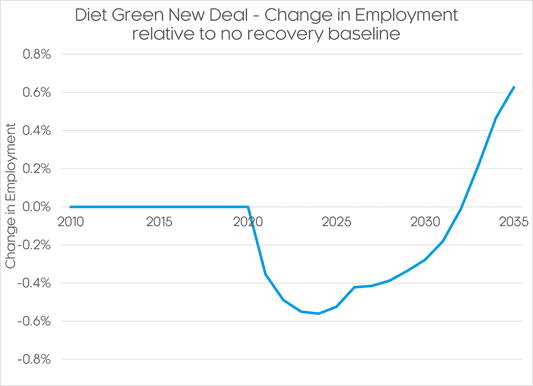
Impacts across different states
Looking at a state level, there are mixed effects, with economic winners and losers depending on how reliant a state is on natural resource extraction or carbon-intensive electricity production.
- In Georgia, changes in GDP are like the dynamics at the national level, with the initial increase in GDP driven by the effects of relief-focused stimulus spending (Chart 3). Investments in low carbon electricity generation drive longer-term growth
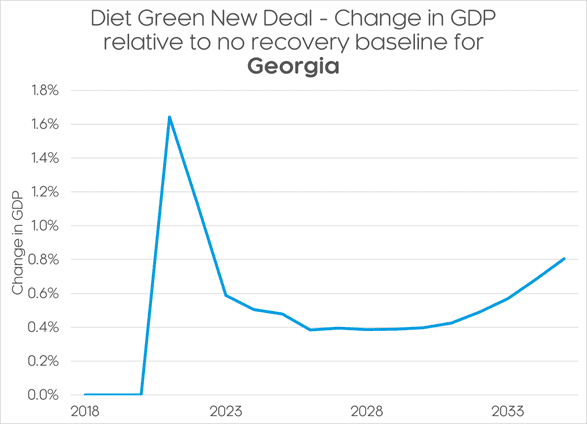
- Wisconsin (Chart 4) and New York (Chart 5) experience similar patterns of change in GDP as in Georgia
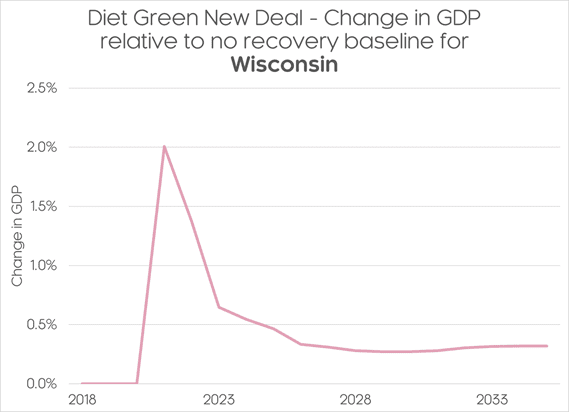
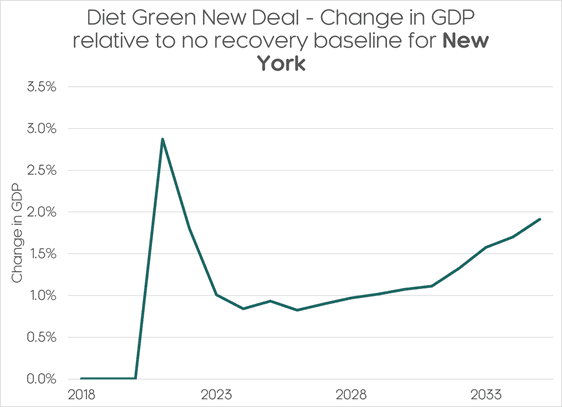
- Colorado experiences a long-term decrease in GDP (Chart 6)
- There is a fall in demand for, and therefore output of carbon-intensive fuel products, which results from a shift towards energy generation from renewables due to policies to support take-up of renewables in the electricity sector
- Natural resource extraction makes up a large component of total output for the state, and as a result, there is a very small decrease in GDP relative to a no-recovery baselines scenario
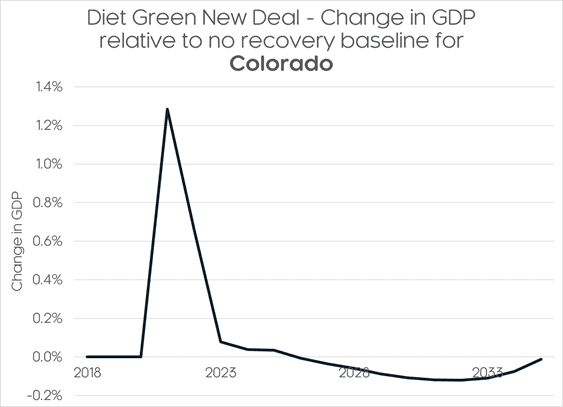
- In West Virginia, increases in output and investment in the electricity sector more than make up for the fall in demand for carbon intensive fuels, even though the latter of these make up a significant share of total state output (Chart 7)
- This is driven by investments in the electricity system geared towards increasing the take-up of low-carbon renewables, and government stimulus focused on short- and medium-term COVID-relief
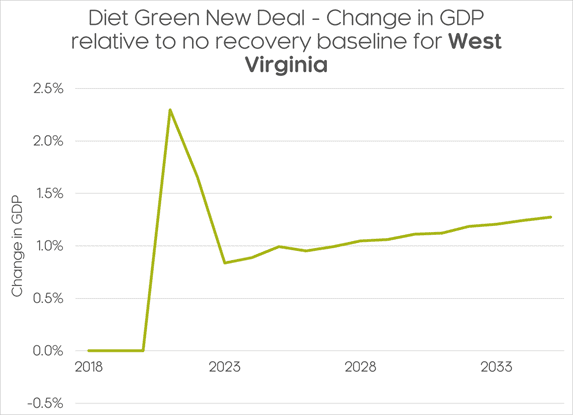
Ambitious Climate Action: Delivering Relief, Recovery and Transformation
The analysis demonstrated that, in most states, there was not a trade-off between reducing emissions and economic activity. Ambitious climate action could improve long term growth trajectories.
States most focused on fossil fuel-related activities are likely to face challenges in restructuring and will need to be supported by further policy to mitigate negative economic impacts.
Looking Ahead
Should the democrats pick up the necessary senate seats in Georgia and retain a slim majority, it is possible that more ambitious policy action could be pursued. It is more likely that the more conservative elements within the Democratic party will negotiate a version of the Green New Deal that allows preferential treatment for a few fossil fuel intensive states, or, does not fully meet the requirements of the Paris Agreement. Perhaps, in light of the current political landscape, a ‘Diet’ option is the most likely path to get the ball rolling on federal-level climate policy.
Sign up to our newsletter for quarterly news, opinions and insights from around the world.